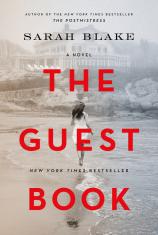Interview: May 8, 2019
Moving through three generations and back and forth in time, THE GUEST BOOK is Sarah Blake's triumphant new novel that tells the story of a family and a country that buries its past in quiet, until the present calls forth a reckoning. In this interview, conducted by Bookreporter.com reviewer Amy Haddock, Blake explains her inspiration for writing the book --- her first since 2010’s THE POSTMISTRESS --- how she went about crafting the complex characters of her sweeping family saga, the America that she hopes readers see in the pages of her story, and why she thinks it’s so difficult for some people to see the privilege that exists in their own lives and to speak up when fellow humans are being degraded.
The Book Report Network: What was your inspiration for writing THE GUEST BOOK?
Sarah Blake: I had handed in THE POSTMISTRESS. It was 2009, and the public conversation about race in this country appeared to have shifted with Barack Obama's candidacy and then presidency. Obama's speech in Philadelphia invoking Faulkner’s often-quoted lines “The past is never dead. It’s not even past” came to me both as a call to arms and as a relief, breaking open the silence in which I'd grown up around race. It seemed to me, for the first time in my adult life, that white people and black people in the same rooms were talking openly about the country’s racial past and how that past cues the present. I wanted whatever it was that I was beginning to write to enter that conversation.
At the same time, I knew I also wanted to write a massive juicy multi-generational novel in the spirit of Isabel Allende, Woolf's THE PARGITERS and Galsworthy's The Forsyte Saga. But I knew that if I did tackle that, I'd want to tell it the way the British playwright Tom Stoppard does in his play "Arcadia," which tells the story of one family alternating scene to scene between a narrative playing out in 1816 and in the present, and it goes back and forth between them. But the set is a room in the family's house, so you watch the characters from two eras move in and out of the one room, use the same glasses, pick up the same objects --- past and present sharing the same stage.
I remember sitting in the dark watching that play and thinking, Oh yes, this is how to do it --- show the past and the present going on at the same time, layered on top of each other, but never connecting: the past doesn't know what's coming and the present doesn't know what's past. This seemed the best way to represent history, especially a family history, the way that we echo and repeat our parents and grandparents without knowing them, walking in and out of shared rooms we can't see --- but then, too, this country's history, where who we are and who we were always seem to be hand in hand, though we resist seeing that very fact.
I wanted to see if I could write a "historical" novel that showed past and present as twin faces in the mirror, dramatizing what seems to me the particularly American conundrum --- our history isn't past, it's the present --- and then try and interrogate why that is. What, or who, allows history to loop endlessly here? What might it really mean to have history trapped in us, as James Baldwin has written. Or us trapped in it? What does the trap look like? And given American history and racial memory, is it possible to spring that trap? Finally, I wanted to imagine --- and so to interrogate --- my own place in that trap. And that place was white, Northeastern and moneyed. Old moneyed.
TBRN: This sweeping family saga stretches over three generations and is told from many points of view. How did you go about crafting the complex characters in this family? Did it begin with an individual, a couple, or just an idea?
SB: Initially, it began with the relationship between Evie, the present generation, and her mother, Joan, the generation of the ’50s. I wanted to write about the unknowability of our parents and their lives, and especially how that unknowability haunts us as we ourselves age. I wanted to write the novel to show the wide and windy gaps in really understanding the people we come from, whom we carry inside. And I wanted Evie's present life --- just after her mother has died --- to alternate with Joan's vibrant, active and utterly secret life in the ’50s to play out on the pages, the back and forth highlighting the divide.
Eventually, I realized that the inheritance of silence that Joan passes down would be more poignant, more complicated, if the generation before her --- her mother and her mother's unspoken life --- was also played out. So Kitty was born.
TBRN: You take great care to paint a complex picture of some of the tragedies in history, weaving together the importance of both “the crime” and “the silence.” What America do you hope that readers see in the pages of your story? What “stones of remembrance” do you think we need to place (as individuals or as a society) to keep the past from repeating itself?
SB: I hope that readers see the way that racism and antisemitism can be passed down through generations, carried on in an unbroken silent acceptance of the convention that the system we are in is just how it is, and the past was just how it was. That we are, in fact, separate from the system we live inside, that we have nothing to do with carrying it on. The stumble stones of Berlin to which you are referring --- the brass paving stones embedded in the sidewalks in front of the last place a Jewish person lived or worked before they were taken and deported to their deaths --- showed me the power of a marker to break that silence. The stones of Berlin mark that something happened on that spot, and name to whom. The stones ask you to stop and imagine what happened, but also ask you to imagine who you might have been on that spot. The one taken? The one passing by? Would you have looked? Or looked away? The stone breaks the distance between then and now.
And I wondered, when I first saw these stones years ago, What if this country had put a stone down to mark every spot where an enslaved person was sold, or resold? How would that change this country's memory or story of our collective racial past? The stone would mark the moment of a sale, but it also would mark the moment when the people in the crowd, watching, walking by, turned a black human being into property, thereby not human --- flipping a switch in the imagination that allowed the "everyday wickedness," as the critic A. O. Scott has called 19th-century slavery, to continue. Consequences of that moment are still playing out, that moment in the white imagination still resides in the racial structure in which we all live. The question is: How can we bring the full story of this country's racial past and present onto the surface? How can we trip up the present, and interrupt the narrative, so that we can see anew?
I hoped my novel could work like a stumble stone. The stumble stones form a throughline that demands a confrontation with the past in a way that is happening more and more. The African American History Museum in Washington DC, Bryan Stevenson's Peace and Justice Memorial in Alabama, and the work of Ta-Nehisi Coates and Claudia Rankine establish the throughlines between past and present. Once you see them, looking away becomes harder. The ground shifts beneath your feet.
TBRN: Key characteristics of the individuals you wrote make an indelible mark on readers --- Ogden’s careful ambition and ingrained fairness; Kitty’s ability to charm a room; Joan’s boldness; Evelyn’s propriety (and judgment); Evie’s insightfulness. Is there one character with whom you most identified?
SB: I know it will sound like a cop-out, but honestly one of the great joys of being a writer is that you get to slip into so many cloaks --- of character, of personality, of diction --- wrap them around you and go out into the world. So I identify with all of the characters wholeheartedly in the moments I am writing them, seeing with their eyes, thinking with their brains, responding the way they would. That said, Kitty and Evie were the hardest characters to write, perhaps because I saw too clearly through their eyes. So much of good fiction is born out of characters' self-ignorance, and the arc of their story traces the characters coming to see or to understand the situation they are in. If Evie saw too much, too clearly, too early, for instance, the story would have been DOA! And Kitty's complicated inability to see the consequences of her actions needed to be tempered so that she wasn't monstrous but remained culpable nonetheless.
TBRN: Moss’ simplistic ideals of how to bridge the racial divide are ultimately dismissed by Reg. In the pages of a book, it’s easier to see privilege and the role it plays. So why do you think it’s so difficult for people to see the privilege that exists in their own lives and speak up when fellow humans are degraded, no matter the circumstance?
SB: Coming to see differently what you've always taken as a given is hard. You have to retrain your imagination. So, for instance, to flip the switch on the idea that white supremacy is not only the KKK, white supremacy is also the system this country has established and maintains --- a system designed to keep the lines of power going as they have been, the system we all participate in and so continue --- which takes work. And it's work that forces us to confront our own behavior. No one likes to do that.
But when collective imaginations shift, windows and doors open. Suddenly, what seemed unimaginable becomes the new given. If the collective white imagination can shift to see itself newly, I hope policy can shift. So I think the more we do and say to put the throughlines up on the surface of our attention, and the more we can SHOW how the system of the past is maintained in the present, the better.








